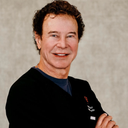I think most plastic surgeons would recommend placing breast implants under the pectoralis muscle.







